How to manage your digital reputation and what metrics to track
According to Vendasta, 58% of executives agree that digital reputation management is crucial, but unfortunately, only 15% commit to it. Few customers these days purchase products without first conducting any online research – this clearly demonstrates the importance of monitoring your brand sentiment.
In the following article, we’re going to share a few tips on how to manage your reputation online. We will also list all the metrics you should track while conducting a reputation analysis.
How to manage your digital reputation?
If you want to ensure that your digital reputation management is comprehensive, we recommend the following:
- Monitor more than just your brand name. It’s also worth tracking key people in your organization, any potential typos, campaign names, competing brands, as well as industry trends.
- Try not to overlook any sources. For many, the term ‘digital reputation management’ automatically brings social media monitoring to mind. And while social media is certainly a very important area to watch, you should also conduct your brand tracking beyond. You can use a tool like SentiOne to monitor other online channels, like blogs, review sites, and news outlets.
- Enable real-time alerts. Choose a solution that allows you to set alerts to any phrases you do not want to be used in association with your brand. Your choice should also detect anomalies (for instance, a sudden spike in online mentions).
- Automate your brand monitoring. With the number of online channels, manual tracking of mentions is impossible – the larger you become, the harder it will be to keep track of all the potential places your brand name can be used in.
Digital reputation management – top metrics worth including in your reputation analysis
Net Promoter Score (NPS)
NPS is arguably the most popular customer loyalty metric tracked by businesses worldwide. Customers are asked “How likely is it that you would recommend us to a friend or colleague?” and to provide you with a numeric answer on a 0-10 scale. People who give you a score between 0-6 are your detractors and are likely to become a source of bad PR. Those who give you a 7 or 8 are known as “passives”, and while they are generally happy, they are unlikely to recommend you to anyone. Finally, 9-10 answers are given by your “promoters”, whom you can expect to keep returning to your business and speak highly of you among friends.
To calculate your NPS score, run a survey and subtract the percentage of detractors from your promoters (the number of neutrals isn’t taken into account). If you’re interested in benchmarks for your industry, here’s a brief overview:
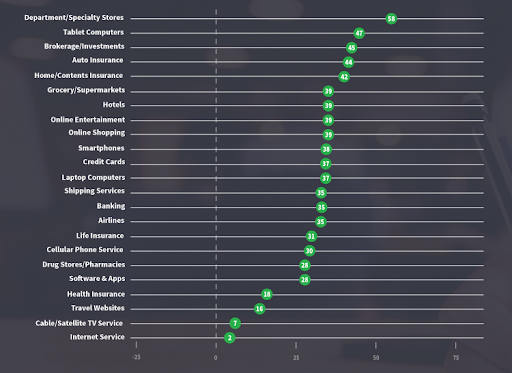
Source: Net Promoter
Customer Satisfaction (CSAT)
CSAT lets you assess your customers’ overall satisfaction scores on a 1-5 scale. If you receive a score lower than 3, there are high chances that something is wrong with either your product’s quality, price, or even the online experience. You should always add a follow-up question for those who give you an unimpressive rating to ask about the reason for their score. You can also do the same for your 4-5 star raters to learn what they particularly like in your offer (if you gain permission, you can even use their answers as social proof on your website!).
Brand Health Index (BHI)
One of the most important brand health metrics, BHI shows you the ratio of positive-to-negative statements you have received in a given time period. To track your score, you’ll need to use a tool with language processing capabilities. Below is an example of the BHI for Hubspot, calculated via the SentiOne platform, based on all online brand mentions between April 2nd, 2020, and April 1st, 2021:
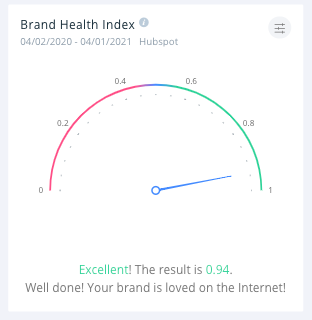
Brand Sentiment
Brand Sentiment is another metric worth including in your reputation analysis. It shows you all the mentions, divided by sentiment: positive, neutral, and negative. As in the case of the above-mentioned NPS, you should not look at the neutral sentiment, but evaluate the proportions between negative and positive mentions. The rule worth remembering here is that you should always keep your negative sentiment under 9%. Here’s an example for Nike – as you can see, the shoe brand is doing a good job at keeping negative mentions under control:
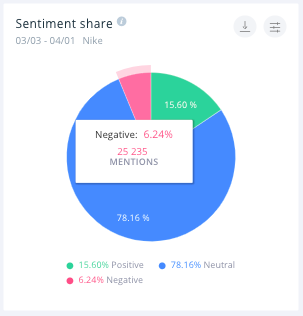
Mentions over time
For effective digital reputation management, we also recommend that you track the volume and type of brand mentions received over a given time period. Use a tool like SentiOne to notice any unusual spikes and understand what might have caused them. Below is a great example from the pharmaceutical company AstraZeneca. You can see a heap on the graph right around the time the brand received much unwanted press regarding their COVID-19 vaccine’s alleged safety concerns:
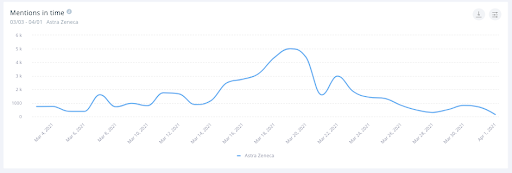
Increase in customers over a given time
PR Daily says that 83% of customers are more likely to buy from a brand if they hear about it from their friends and family. If you’re seeing a steady increase in the number of clients, you can assume at least part of it can be attributed to your good brand reputation. We recommend finding a way to monitor referrals or asking customers in a survey where they first heard about you to assess the power of word-of-mouth referrals.
Google PageRank
Another brand health metric that you should remember about is Google Page Rank. It shows how many domains link back to your site. The higher your brand authority, the higher your PageRank.
Why does it matter?
Just think about it – from a marketing perspective, when you create content would you rather draw inspiration from and therefore link back to a brand with a higher or lower authority? I bet your answer indicates the former, as they are usually well-known and highly respected businesses. Companies that have a high domain authority tend to rank better in Google, get more exposure, and are perceived as more trustworthy.
Returning customers
Do you know how many of your first-time buyers become regular customers? Part of effective digital reputation management should be ensuring that your customers return to you regularly. If they frequently visit your site and convert, high chances are they like your products, which might also mean they approve of your brand. If, on the other hand, they hardly ever return, then it might indicate some product quality issue, which – if not addressed – might negatively impact your brand image.
Social media likes and followers
Your social media likes and followers is another brand health metric that you should consider tracking regularly. Are you gaining or losing social media followers and likes? You can check it directly within a social media platform like Facebook, or you can use an external social media management platform like Buffer to track it.
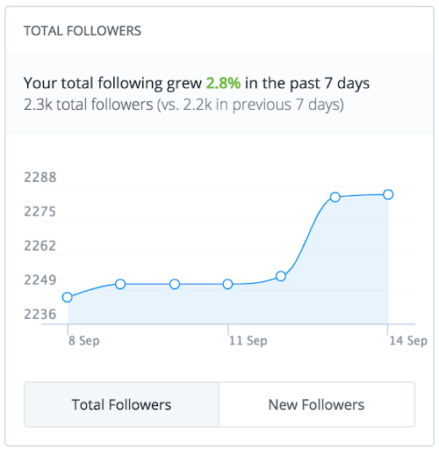
Source: Buffer
If the number of your followers is increasing continuously it’s a good indicator that what you say or do as a brand resonates with your customers or prospects.
Star ratings
93% of people read online reviews prior to purchasing. Therefore, when you conduct your reputation analysis it’s always worth taking a quick look at your rating on sites like G2, Serchen, Capterra, Google Reviews, and social media. Below is an example of a SentiOne listing from G2.

Source: G2
Quite frequently, buyers will start their brand/product research by taking a quick look at your star rating. If you spot any negative reviews, respond to them fast. Occasionally, if you tackle the issue the right way, the reviewers might change their score. This is critically important, as 3.3 stars is the minimum score a business must have to be even considered by customers.
Summary
While digital reputation management might seem like an overwhelming task – especially considering the number of online channels and the volume of comments – it doesn’t have to be one. The key is to use the right tools and know which statistics and data points to pay attention to the most.
There are a number of brand health metrics we recommend tracking, including:
- Brand Health Index
- Sentiment share
- Number of mentions over time
- Social media likes and followers
All of the above can be monitored by using an online reputation management platform like SentiOne. Unlike many other similar tools, it lets you stay informed on how your brand is discussed not just on social media, but also other online outlets like blogs, review sites, and news sites. Reach out to learn more or to schedule a free demo!



